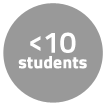Instructor Insights pages are part of the OCW Educator initiative, which seeks to enhance the value of OCW for educators.
Course Overview
This page focuses on the course 7.342 Pluripotent Stem Cells and Genome Engineering for Modeling Human Diseases as it was taught by Postdoctoral Associate Katherine Wert and Postdoctoral Associate Malkiel Cohen in Spring 2015.
In our course, we discuss the past, current and future methodology for modeling human disease, side by side with a broad introduction for the undergraduate students to stem cell biology. We will further discuss the advancements and improvements of these methods and the importance and relevance of using stem cells to model disease. The first half of our course covers the background of stem cell biology: from teratocarcinoma cells and the development of mouse embryonic stem cells, to using these cells for the creation of transgenic animals via genome engineering, to the development of human embryonic and reprogrammed pluripotent cells and their use in modeling various complex human diseases. The second half of our course covers the current hot topics in genome engineering using stem cells; such as ZNF, TALEN, CRISPR/Cas9, transdifferentiation, and 3-D culture systems.
Course Outcomes
Course Goals for Students
The goal of our course is to provide a broad introduction to the field of stem cell biology and genome engineering, and how these methods have progressed the ability to model complex human diseases. We encourage active participation in the discussions of the course, to help students learn how to critically read and approach primary scientific literature. We will also enhance the students’ capabilities in not only understanding the primary scientific literature, but what the next future steps should be for the work that we discuss in the course.
Possibilities for Further Study/Careers
Students taking this course are typically interested in careers in medicine, engineering, or biological research, although the speaking and reading skills gained in the course can work for any future profession.
Curriculum Information
Prerequisites
- 7.03 Genetics
- 7.05 General Biochemistry
- 7.06 Cell Biology
- 7.28 Molecular Biology
Requirements Satisfied
None.
Offered
Seminars are offered each semester and are topic-based.
Assessment
The class is graded on a pass / fail basis, and grades are determined by student participation and engagement in the course topics, as well as by attendance at each class session and completion of the oral presentation (halfway through the term) and the final written assignment.
Student Information

Breakdown by Year
This course is designed for upperclassmen (third and fourth year college students) as based on the pre-requisite requirements.
Breakdown by Major
Students are typically from biology or engineering majors, however we are open to accepting college students in years one and two as well as those from other majors.
Enrollment Cap
Class size is limited to 8.
During an average week, students were expected to spend 6 hours on the course, roughly divided as follows:
Seminar Meeting
- Met one time per week for 2 hours per session; 14 sessions total.
- Each week, two scientific manuscripts were be assigned as required reading for the following week.
- The class sessions began with students summarizing the manuscripts, discussing each figure and table, the experimental methods, the key experiments and the key control experiments, the author's conclusions, potential future experiments and the meaning of this research work in regards to the specific research field.
- In the final ten minutes of the class period, the instructors introduced the upcoming topic for the following week to provide any information necessary for students to understand the upcoming required reading.
Out of Class
- Reading assignments – two journal articles per week
- Oral Presentation
- Written Assignment
Semester Breakdown
| WEEK | M | T | W | Th | F |
|---|---|---|---|---|---|
| 1 |  |  |  |  |  |
| 2 |  |  |  |  |  |
| 3 |  |  |  |  |  |
| 4 |  |  |  |  |  |
| 5 |  |  |  |  |  |
| 6 |  |  |  |  |  |
| 7 |  |  |  |  |  |
| 8 |  |  |  |  |  |
| 9 |  |  |  |  |  |
| 10 |  |  |  |  |  |
| 11 |  |  |  |  |  |
| 12 |  |  |  |  |  |
| 13 |  |  |  |  |  |
| 14 |  |  |  |  |  |
| 15 |  |  |  |  |  |
| 16 |  |  |  |  |  |
 No classes throughout MIT
No classes throughout MIT Seminar session
Seminar session Written assignment due date
Written assignment due date No class session scheduled
No class session scheduled Oral presentations
Oral presentations